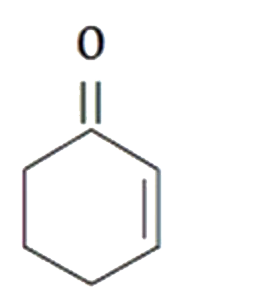In the given reaction,
OHC−(CH2)3−O∣∣C−CH3ΘOH/Δ−−−−→(X)'
the major product 'X' will be




The correct Answer is:A
To solve the problem, we need to analyze the reaction step by step. The reaction involves an aldehyde and a ketone, and under the influence of a base and heat, it leads to the formation of a product through an intramolecular aldol condensation.
1. Identify the Reactants:
The reactant structure is given as OHC−(CH2)3−C(=O)−CH3. This indicates that we have an aldehyde (CHO) at one end and a ketone (C=O) at the other end, with a three-carbon chain in between.
2. Recognize the Functional Groups:
The aldehyde group (CHO) and the ketone group (C=O) are both carbonyl groups. The carbon adjacent to the carbonyl group (the alpha carbon) has alpha hydrogens that can be removed by a base.
3. Base-Induced Deprotonation:
When a base is added, it will deprotonate one of the alpha hydrogens adjacent to the carbonyl group. In this case, we can remove one of the alpha hydrogens from the carbon chain (the CH2 group next to the ketone).
4. Formation of the Nucleophile:
After deprotonation, we will have a negatively charged nucleophile (CH2^-). This nucleophile will then attack the carbonyl carbon of the aldehyde.
5. Nucleophilic Attack:
The nucleophile (CH2^-) attacks the carbonyl carbon of the aldehyde. This forms a six-membered cyclic intermediate (a tetrahedral intermediate) as the nucleophile adds to the carbonyl carbon.
6. Formation of the Aldol Product:
The six-membered ring is formed by the nucleophilic attack. The structure now has a hydroxyl group (OH) and a ketone group (C=O) in the same molecule.
7. Dehydration Step:
Upon heating, the hydroxyl group (OH) can be eliminated along with a hydrogen atom from the adjacent carbon, leading to the formation of a double bond (C=C). This dehydration step results in the formation of an α,β-unsaturated carbonyl compound.
8. Final Product:
The final product after dehydration will be a compound with a double bond between the alpha and beta carbons relative to the carbonyl group.
Conclusion:
The major product 'X' formed from the reaction is an α,β-unsaturated carbonyl compound.
The reactant structure is given as OHC−(CH2)3−C(=O)−CH3. This indicates that we have an aldehyde (CHO) at one end and a ketone (C=O) at the other end, with a three-carbon chain in between.
The aldehyde group (CHO) and the ketone group (C=O) are both carbonyl groups. The carbon adjacent to the carbonyl group (the alpha carbon) has alpha hydrogens that can be removed by a base.
When a base is added, it will deprotonate one of the alpha hydrogens adjacent to the carbonyl group. In this case, we can remove one of the alpha hydrogens from the carbon chain (the CH2 group next to the ketone).
After deprotonation, we will have a negatively charged nucleophile (CH2^-). This nucleophile will then attack the carbonyl carbon of the aldehyde.
The nucleophile (CH2^-) attacks the carbonyl carbon of the aldehyde. This forms a six-membered cyclic intermediate (a tetrahedral intermediate) as the nucleophile adds to the carbonyl carbon.
The six-membered ring is formed by the nucleophilic attack. The structure now has a hydroxyl group (OH) and a ketone group (C=O) in the same molecule.
Upon heating, the hydroxyl group (OH) can be eliminated along with a hydrogen atom from the adjacent carbon, leading to the formation of a double bond (C=C). This dehydration step results in the formation of an α,β-unsaturated carbonyl compound.
The final product after dehydration will be a compound with a double bond between the alpha and beta carbons relative to the carbonyl group.
The major product 'X' formed from the reaction is an α,β-unsaturated carbonyl compound.
Similar Questions
Knowledge Check
H3C−CH2−O∣∣C−CH3ϴOD/D2−−−−→ Final product is
AH3C−CD2−O∣∣C−CH3BCH3−CH2−O∣∣C−CD3CD3C−CD2−O∣∣C−CD3DCH3−CD2−O∣∣C−CD3CH3CH2−O∣∣C−CH3NaNO2−−−−→HCl, Major product of this reaction is :
ACH3C∣NOH−O∣∣C−CH3BCH3−CH2−O∣∣C−CH=N−OHC D
D
In the given reaction CH3−CH2−Br∣CH−CH=CH2Alc.KOH/Δ−−−−−−−−→(X) X will be
View SolutionIn the given reaction CH3−CH3∣C∣CH3−CH2−BrΔ−−→[X]
[X] will be
View SolutionMajor product of given reaction is -
O2N−CH2−C∣ClH−CH3ΘOH−−→Δ Major product
View SolutionIn the given reaction,
CH3−CH∣CH3−O∣∣C−CH2−CH3CF3CO3H−−−−−→(X)
as main product, 'X' will be
View SolutionIn the given reaction
CH3−O∣∣C−C2H5X−−→CH3−CH2−C2H5
'X' will be
View SolutionOHC(CH2)3COCH3OH−−−→Δ
The major product is ?
View Solution
